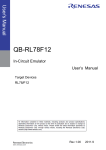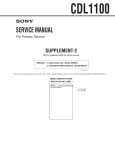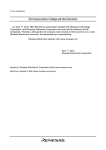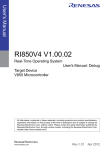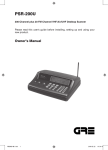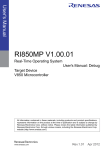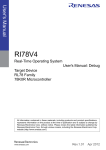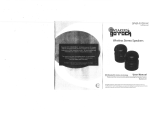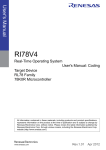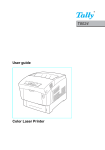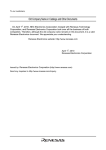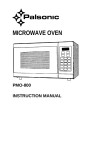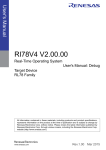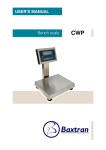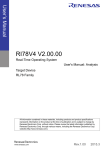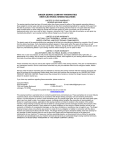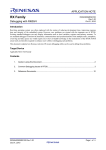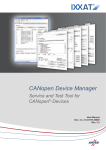Download RI78V4 Real-Time Operating System User`s Manual: Analysis
Transcript
User’s Manual RI78V4 Real-Time Operating System User’s Manual: Analysis Target Tool RI78V4 All information contained in these materials, including products and product specifications, represents information on the product at the time of publication and is subject to change by Renesas Electronics Corp. without notice. Please review the latest information published by Renesas Electronics Corp. through various means, including the Renesas Electronics Corp. website (http://www.renesas.com). www.renesas.com Rev.1.00 Apr 2011 Notice 1. 2. 3. 4. 5. 6. 7. All information included in this document is current as of the date this document is issued. Such information, however, is subject to change without any prior notice. Before purchasing or using any Renesas Electronics products listed herein, please confirm the latest product information with a Renesas Electronics sales office. Also, please pay regular and careful attention to additional and different information to be disclosed by Renesas Electronics such as that disclosed through our website. Renesas Electronics does not assume any liability for infringement of patents, copyrights, or other intellectual property rights of third parties by or arising from the use of Renesas Electronics products or technical information described in this document. No license, express, implied or otherwise, is granted hereby under any patents, copyrights or other intellectual property rights of Renesas Electronics or others. You should not alter, modify, copy, or otherwise misappropriate any Renesas Electronics product, whether in whole or in part. Descriptions of circuits, software and other related information in this document are provided only to illustrate the operation of semiconductor products and application examples. You are fully responsible for the incorporation of these circuits, software, and information in the design of your equipment. Renesas Electronics assumes no responsibility for any losses incurred by you or third parties arising from the use of these circuits, software, or information. When exporting the products or technology described in this document, you should comply with the applicable export control laws and regulations and follow the procedures required by such laws and regulations. You should not use Renesas Electronics products or the technology described in this document for any purpose relating to military applications or use by the military, including but not limited to the development of weapons of mass destruction. Renesas Electronics products and technology may not be used for or incorporated into any products or systems whose manufacture, use, or sale is prohibited under any applicable domestic or foreign laws or regulations. Renesas Electronics has used reasonable care in preparing the information included in this document, but Renesas Electronics does not warrant that such information is error free. Renesas Electronics assumes no liability whatsoever for any damages incurred by you resulting from errors in or omissions from the information included herein. Renesas Electronics products are classified according to the following three quality grades: “Standard”, “High Quality”, and “Specific”. The recommended applications for each Renesas Electronics product depends on the product’s quality grade, as indicated below. You must check the quality grade of each Renesas Electronics product before using it in a particular application. You may not use any Renesas Electronics product for any application categorized as “Specific” without the prior written consent of Renesas Electronics. Further, you may not use any Renesas Electronics product for any application for which it is not intended without the prior written consent of Renesas Electronics. Renesas Electronics shall not be in any way liable for any damages or losses incurred by you or third parties arising from the use of any Renesas Electronics product for an application categorized as “Specific” or for which the product is not intended where you have failed to obtain the prior written consent of Renesas Electronics. The quality grade of each Renesas Electronics product is “Standard” unless otherwise expressly specified in a Renesas Electronics data sheets or data books, etc. “Standard”: 8. 9. 10. 11. 12. Computers; office equipment; communications equipment; test and measurement equipment; audio and visual equipment; home electronic appliances; machine tools; personal electronic equipment; and industrial robots. “High Quality”: Transportation equipment (automobiles, trains, ships, etc.); traffic control systems; anti-disaster systems; anticrime systems; safety equipment; and medical equipment not specifically designed for life support. “Specific”: Aircraft; aerospace equipment; submersible repeaters; nuclear reactor control systems; medical equipment or systems for life support (e.g. artificial life support devices or systems), surgical implantations, or healthcare intervention (e.g. excision, etc.), and any other applications or purposes that pose a direct threat to human life. You should use the Renesas Electronics products described in this document within the range specified by Renesas Electronics, especially with respect to the maximum rating, operating supply voltage range, movement power voltage range, heat radiation characteristics, installation and other product characteristics. Renesas Electronics shall have no liability for malfunctions or damages arising out of the use of Renesas Electronics products beyond such specified ranges. Although Renesas Electronics endeavors to improve the quality and reliability of its products, semiconductor products have specific characteristics such as the occurrence of failure at a certain rate and malfunctions under certain use conditions. Further, Renesas Electronics products are not subject to radiation resistance design. Please be sure to implement safety measures to guard them against the possibility of physical injury, and injury or damage caused by fire in the event of the failure of a Renesas Electronics product, such as safety design for hardware and software including but not limited to redundancy, fire control and malfunction prevention, appropriate treatment for aging degradation or any other appropriate measures. Because the evaluation of microcomputer software alone is very difficult, please evaluate the safety of the final products or system manufactured by you. Please contact a Renesas Electronics sales office for details as to environmental matters such as the environmental compatibility of each Renesas Electronics product. Please use Renesas Electronics products in compliance with all applicable laws and regulations that regulate the inclusion or use of controlled substances, including without limitation, the EU RoHS Directive. Renesas Electronics assumes no liability for damages or losses occurring as a result of your noncompliance with applicable laws and regulations. This document may not be reproduced or duplicated, in any form, in whole or in part, without prior written consent of Renesas Electronics. Please contact a Renesas Electronics sales office if you have any questions regarding the information contained in this document or Renesas Electronics products, or if you have any other inquiries. (Note 1) “Renesas Electronics” as used in this document means Renesas Electronics Corporation and also includes its majorityowned subsidiaries. (Note 2) “Renesas Electronics product(s)” means any product developed or manufactured by or for Renesas Electronics. How to Use This Manual Readers This manual is intended for users who design and develop application systems using 78K0R microcontroller or RL78 family products. Purpose This manual is intended for users to understand the functions of real-time OS " RI78V4" manufactured by Renesas Electronics, described the organization listed below. Organization This manual consists of the following major sections. CHAPTER 1 GENERAL CHAPTER 2 FUNCTIONS APPENDIX A WINDOW REFERENCE APPENDIX B MESSAGES APPENDIX C INDEX How to read this manual It is assumed that the readers of this manual have general knowledge in the fields of electrical engineering, logic circuits, microcontrollers, C language, and assemblers. To understand the hardware functions of the 78K0R microcontroller or RL78 family → Refer to the User’s Manual of each product. Conventions Data significance: Higher digits on the left and lower digits on the right Note: Footnote for item marked with Note in the text Caution: Information requiring particular attention Remark: Supplementary information Numerical representation: Binary...XXXX or XXXXB Decimal...XXXX Hexadecimal...0xXXXX Prefixes indicating power of 2 (address space and memory capacity): K (kilo) 210 = 1024 M (mega) 220 = 10242 Related Documents Refer to the documents listed below when using this manual. The related documents indicated in this publication may include preliminary versions. However, preliminary versions are not marked as such. Documents related to development tools (User’s Manuals) Document Name RI Series RI78V4 RI850V4 Document No. Start R20UT0509E Message R20UT0510E Coding R20UT0511E Debug R20UT0520E Analysis This document Internal Structure R20UT0514E Coding R20UT0515E Debug R20UT0516E Analysis R20UT0517E Internal Structure R20UT0518E RI850MP Coding R20UT0519E CubeSuite+ Start R20UT0545E Integrated Development Environment 78K0 Design R20UT0546E 78K0R Design R20UT0547E RL78 Design R20UT0548E V850 Design R20UT0549E R8C Design R20UT0550E 78K0 Coding R20UT0551E Caution RL78,78K0R Coding R20UT0552E V850 Coding R20UT0553E Coding for CX Compiler R20UT0554E R8C Coding R20UT0576E 78K0 Build R20UT0555E RL78,78K0R Build R20UT0556E V850 Build R20UT0557E Build for CX Compiler R20UT0558E R8C Build R20UT0575E 78K0 Debug R20UT0559E 78K0R Debug R20UT0560E RL78 Debug R20UT0561E The related documents listed above are subject to change without notice. Be sure to use the latest edition of each document when designing. All trademarks or registered trademarks in this document are the property of their respective owners. [MEMO] [MEMO] [MEMO] TABLE OF CONTENTS CHAPTER 1 GENERAL ... 9 1.1 Overview ... 9 1.2 Features ... 9 CHAPTER 2 FUNCTIONS ... 10 2.1 Trace Form ... 10 2.2 Trace Data ... 10 2.2.1 Collecting positions and collected data ... 10 2.2.2 Time an accuracy ... 11 2.3 Debugging Procedure ... 12 APPENDIX A WINDOW REFERENCE ... 17 A.1 Description ... 17 APPENDIX B MESSAGES ... 58 B.1 Overview ... 58 B.2 Error Messages ... 58 APPENDIX C INDEX ... 60 RI78V4 Ver.1.00.00 CHAPTER 1 GENERAL CHAPTER 1 GENERAL The CubeSuite+ is an integrated development environment used to carry out tasks such as design, coding, build and debug for developing application systems for microcontrollers manufactured by Renesas Electronics. This manual describes the performance analyzer. This tool is useful for analyzing programs using the "RI78V4" realtime OS functionality within this integrated program-development process. 1.1 Overview As the performance of microprocessors has increased, application programs have grown in scale and complexity. With conventional debuggers, theoretical debugging of such application programs is simple, but time-related analysis is not. It is difficult and takes a very long time, for example, to analyze errors such as those caused by incorrect processing timing, or to evaluate the performance of the entire system. To solve these problems, Renesas Electronics Corporation has developed powerful microprocessors such as the RL78, 78K0R. Renesas Electronics Corporation also provides the performance analyzer to support the quantitative performance analysis of programs. The performance analyzer is a performance analysis tool for examining the execution transition statuses and the CPU usage of processing programs that embed the RI78V4 for the RL78, 78K0R. Being connected with the CubeSuite+, the performance analyzer achieves a function for collecting data of tracing the event occurrences (issuance of service calls, occurrence of interrupts, etc.) and presenting the trace data graphically. The performance analyzer therefore allows the user to readily analyze the execution transition statuses and the CPU usage of processing programs. 1.2 Features The performance analyzer has the following features: - Graphical display of the execution transition statuses of processing programs The graphically displayed the execution transition status of the processing program in which the RI78V4 is embedded (horizontal axis = time, vertical axis = task name, etc.) permits analysis of execution transition statuses, such as task switching caused by service call issuance and transferring the control to the interrupt handler caused by the occurrence of interrupts. Since all accesses to an object (such as semaphore or eventflag) are marked upon issuance of a service call from a processing program, the usage of objects can also be checked. - Graphical display of the CPU usage of processing programs The CPU usage (total execution time, code coverage, etc.) of a processing program executed within a specified section can be displayed, which enables the quantitative performance analysis for processing programs. - Linking with the CubeSuite+ The performance analyzer can open the Editor panel, Disassemble panel, and Memory panel of the CubeSuite+, which enables quick identification of locations where a problem has occurred. R20UT0513EJ0100 Rev.1.00 Apr 01, 2011 Page 9 of 64 RI78V4 Ver.1.00.00 CHAPTER 2 FUNCTIONS CHAPTER 2 FUNCTIONS This chapter describes main functions of the performance analyzer. 2.1 Trace Form The performance analyzer supports the following trace form. - Hard trace form Using the trace function provided by the debug tool that is connected to the CubeSuite+, the performance analyzer collects trace data and stores it to the trace memory of the debug tool. Using this form, trace data can therefore be collected without modifying the processing program code. Remark The performance analyzer uses the following resources of the debug tool, when switching the AZ trace mode to the ON state. Resource Name Required Quantity Point trace event (for write access) 2.2 1 Trace Data 2.2.1 Collecting positions and collected data The following lists the trace data to be collected and positions where they are collected. Table 2-1. Collected Trace Data and Collecting Positions Collecting Positions Service call entry Collected Data Time Service call function code ID of object subject to execution by service call Service call issuance address Service call exit Time Service call return value Interrupt handler entry Time Address at which execution returns from interrupt handler Interrupt handler exit Time Occurrence of task switching Time ID of a task to which the operation will move (or ID that indicates idle routine is entered) Task entry Time ID of task to be activated Task activation address Note that the following items cannot be detected as trace data for the performance analyzer. - Address at which ext_tsk is issued - Entry/exit of reset, NMI, exception (software exception, exception trap) - Entry/exit of maskable interrupts whose interrupt handler has not been registered R20UT0513EJ0100 Rev.1.00 Apr 01, 2011 Page 10 of 64 RI78V4 Ver.1.00.00 CHAPTER 2 FUNCTIONS - Boot processing entry/exit - Initialization routine entry/exit - Cyclic handler entry/exit Since the RI78V4 assigns the same function code to service call names to which an "i" is prefixed/not prefixed listed below, the performance analyzer cannot identified them. The performance analyzer therefore handles these service calls without an "i" being prefixed. - sta_tsk/ista_tsk - chg_pri/ichg_pri - can_wup/ican_wup - sus_tsk/isus_tsk - rsm_tsk/irsm_tsk - frsm_tsk/ifrsm_tsk 2.2.2 Time an accuracy - When using the IECUBE as debug tool The accuracy of the time collected as trace data depends on the setting of the [Rate of frequency division of trace time tag] property in the [Trace] category of the [Debug Tool Settings] tab in the Property panel of the CubeSuite+. If the system clock is set to the STOP or IDLE mode, however, the performance analyzer cannot collect an accurate time, and the collected value is therefore not guaranteed (This is because the performance analyzer calculates the time taken by processing program execution, based on the system clock.). - When using the simulator as debug tool Specify [No] with the [Accumulate trace time] property in the [Trace] category on the [Debug Tool Settings] tab in the Property panel of the CubeSuite+. Unless this property is set to [No], the accurate time cannot be collected. R20UT0513EJ0100 Rev.1.00 Apr 01, 2011 Page 11 of 64 RI78V4 Ver.1.00.00 2.3 CHAPTER 2 FUNCTIONS Debugging Procedure This section describes the procedure for debugging using the performance analyzer. (1) Stating CubeSuite+ Start the CubeSuite+ and then connect the debug tool to be used to it (select the [Debug] menu >> [Connect to Debug Tool] in the Main window of the CubeSuite+). (2) Starting performance analyzer Start the performance analyzer to be used (select the [View] menu >> [Real-time OS] >> [Performance Analyzer] in the Main window of the CubeSuite+). After the performance analyzer is started, the following AZ78K0R window appears. At this time, make sure that the message "Connected" is displayed on the statusbar (Connection status area) in the AZ78K0R window. Figure 2-1. Starting Performance Analyzer Confirm that "Connected" is displayed (3) Downloading a load module Download the load module (select the [Debug] menu >> [Download]) that has been linked with the RI78V4 into the debug tool. At this time, make sure that the message "RX Loaded" is displayed on the statusbar (Load module status area) in the AZ78K0R window. Figure 2-2. Downloading A Load Module Confirm that "RX Loaded" is displayed R20UT0513EJ0100 Rev.1.00 Apr 01, 2011 Page 12 of 64 RI78V4 Ver.1.00.00 CHAPTER 2 FUNCTIONS (4) Switching the AZ trace mode Click the button in the AZ78K0R window to turn on AZ trace mode. At this time, make sure that the message "AZ Trace ON" is displayed on the statusbar (AZ trace mode status area) in the AZ78K0R window. Figure 2-3. Switching The AZ Trace Mode Confirm that "AZ Trace ON" is displayed (5) Execution of processing program Run the processing program on the CubeSuite+. Collection of trace data then starts. (6) Stop of processing program Stop execution of the processing program on the CubeSuite+. If a breakpoint has been set, wait until the processing program breaks. Collection of trace data then ends. (7) Loading of trace data Click the button in the AZ78K0R window to load trace data collected for the performance analyzer. R20UT0513EJ0100 Rev.1.00 Apr 01, 2011 Page 13 of 64 RI78V4 Ver.1.00.00 CHAPTER 2 FUNCTIONS (8) Verification in AZ:Analyze window Click the button in the AZ78K0R window to open the AZ:Analyze window. In this window and each of the windows that can be opened from this window, analysis related to time, such as bugs caused by processing timing and evaluation of entire system performance. Figure 2-4. Verification in AZ:Analyze Window Remark For how to read the execution transition map displayed in this window, refer to "[How to read execution transition map]" and "[How to verify execution transition map]". R20UT0513EJ0100 Rev.1.00 Apr 01, 2011 Page 14 of 64 RI78V4 Ver.1.00.00 CHAPTER 2 FUNCTIONS (9) Verification in Pattern Search dialog box Click the button in the AZ:Analyze window to open the Pattern Search dialog box. In this window, the point at which a specific event occurred can be searched for, based on the execution transition map displayed in the AZ:Analyze window. Figure 2-5. Verification in Pattern Search Dialog Box Remark For how to search for the point at which a specific event occurred, refer to "[How to search]". (10) Verification in AZ:Cpu window Click the button in the AZ:Analyze window to open the AZ:Cpu window. In this window, the CPU usage in a section between the up cursor and down cursor in the AZ:Analyze window can be checked. Figure 2-6. Verification in AZ:Cpu Window Remark For how to count the CPU usage, refer to "[Count method]". R20UT0513EJ0100 Rev.1.00 Apr 01, 2011 Page 15 of 64 RI78V4 Ver.1.00.00 CHAPTER 2 FUNCTIONS (11) Verification in AZ:Trace View window Click the button in the AZ:Analyze window to open the AZ:Trace View window. In this window, information obtained from the execution transition map in the AZ:Analyze window can be viewed in list form. Figure 2-7. Verification in AZ:Trace View Window Remark For how to read the list displayed in this window, refer to "[How to read the list]". (12) Verification in Trace Search dialog box Click the [View] menu >> [Find...] in the AZ:Trace View window to open the Trace Search dialog box. In this window, specific information (trace data) can be searched for from the list displayed in the AZ:Trace View window. Figure 2-8. Verification in Trace Search Dialog Box Remark For how to search for specific information (trace data), refer to "[How to search]". R20UT0513EJ0100 Rev.1.00 Apr 01, 2011 Page 16 of 64 RI78V4 Ver.1.00.00 APPENDIX A WINDOW REFERENCE APPENDIX A WINDOW REFERENCE This appendix provides detailed explanations of windows and dialog boxes used for analyzing with the performance analyzer. A.1 Description The following shows the list of windows and dialog boxes of the performance analyzer. Table A-1. List of Windows and Dialog Boxes Window/Dialog Box Name AZ78K0R window Open/Save As dialog box Function Central window for using the functions provided by the performance analyzer. Specifies the file name when loading a file that contains information to be displayed in the AZ:Analyze window and AZ:Cpu window, or when saving information displayed in the AZ:Analyze window, AZ:Cpu window and AZ:Trace View window as a file. AZ:Analyze window Displays information obtained from the trace data loaded into the AZ78K0R window, in the form of an execution transition map. Pattern Search dialog box Searches for the point at which a specific event occurred, based on the execution transition map displayed in the AZ:Analyze window. AZ:Cpu window Displays the CPU usage in a section between the up cursor and down cursor in the AZ:Analyze window. AZ:Trace View window Lists information obtained from the execution transition map in the AZ:Analyze window. Trace Search dialog box Searches for specific information (trace data) based on the list displayed in the AZ:Trace View window. About dialog box Displays the version information of the performance analyzer. AZ:Error dialog box Displays the error information of the performance analyzer. R20UT0513EJ0100 Rev.1.00 Apr 01, 2011 Page 17 of 64 RI78V4 Ver.1.00.00 APPENDIX A WINDOW REFERENCE AZ78K0R window Central window for using the functions provided by the performance analyzer. Figure A-1. AZ78K0R Window (1) (2) (3) The following items are explained here. - [How to open] - [Description of each area] - [Caution] [How to open] - In the menubar of the main window, select [Realtime OS] >> [Performance Analyzer] from the [View] menu. [Description of each area] (1) Menubar This bar consists of the following menu items. (a) [File] menu Exit Terminates the performance analyzer. The function of this item is same as that of the button. (b) [Option] menu Tool Bar Switches displaying and hiding the Toolbar (default: displayed). Status Bar Switches displaying and hiding the Statusbar (default: displayed). (c) [Operation] menu AZ Trace ON Turns on the AZ trace mode. Trace data is collected into the trace memory of the debug tool by running a processing program while the AZ trace mode is ON. The function of this item is same as that of the R20UT0513EJ0100 Rev.1.00 Apr 01, 2011 button. Page 18 of 64 RI78V4 Ver.1.00.00 AZ Trace OFF APPENDIX A WINDOW REFERENCE Turns off the AZ trace mode. Trace data is not collected into the trace memory of the debug tool if a processing program is executed while the AZ trace mode is OFF. The function of this item is same as that of the Upload button. Loads trace data stored in the trace memory. The AZ trace mode is automatically turned off when loading of trace data is finished. This menu is unavailable if trace data has not been collected. The function of this item is same as that of the button. (d) [Browse] menu Analyze... Opens the AZ:Analyze window in Active mode. If loading of trace data has been finished in this window, the execution transition map is displayed in the corresponding window. The function of this item is same as that of the button. (e) [Window] menu Close All Closes windows and dialog boxes other than this window. (f) [Help] menu This Window Displays the help widnow for this window. Help Topics Opens the online help, with the [Search] tab displayed. About... Opens the About dialog box. The version information of the performance analyzer is displayed. (2) Toolbar This bar consists of the following buttons. Switches the AZ trace mode. Trace data is collected into the trace memory of the debug tool by running a processing program while the AZ trace mode is ON. Trace data is not collected into the trace memory of the debug tool if a processing program is executed while the AZ trace mode is OFF. The function of this item is the same as that of [AZ Trace ON] or [AZ Trace OFF] int the [Operation] menu. Loads trace data stored in the trace memory. The AZ trace mode is automatically turned off when loading of trace data is finished. This button is unavailable if trace data has not been collected. The function of this item is the same as that of [Upload] int the [Operation] menu. Opens the AZ:Analyze window in Active mode. If loading of trace data has been finished in this window, the execution transition map is displayed in the corresponding window. The function of this item is the same as that of [Analyze...] int the [Browse] menu. R20UT0513EJ0100 Rev.1.00 Apr 01, 2011 Page 19 of 64 RI78V4 Ver.1.00.00 APPENDIX A WINDOW REFERENCE (3) Statusbar This bar consists of the following areas. Figure A-2. Statusbar (AZ78K0R Window) (a) (b) (c) (d) (a) Connection status area This area indicates the status of connection with the CubeSuite+. Connected Connected to the CubeSuite+. Not Connected Not connected to the CubeSuite+. (b) Load module status area This area indicates the state of the load module to be loaded onto the debug tool. This area is not displayed if the performance analyzer is not connected to the CubeSuite+. RX Loaded A load module linked with the RI78V4 has been downloaded. RX None No load modules linked with the RI78V4 have been downloaded. (c) Load module execution status area This area indicates the state of the program execution. This area is not displayed if the performance analyzer is not connected to the CubeSuite+. Running Status of program being execution. Breaked Status of program operation undergoing break. (d) AZ trace mode status area This area indicates the current state of AZ trace mode. This area is not displayed when the performance analyzer is not connected with the CubeSuite+, or if no load modules linked with the RI78V4 have been downloaded. AZ Trace ON Status where AZ trace ON has been set. AZ Trace OFF Status where AZ trace OFF has been set. R20UT0513EJ0100 Rev.1.00 Apr 01, 2011 Page 20 of 64 RI78V4 Ver.1.00.00 APPENDIX A WINDOW REFERENCE [Caution] - When switching the AZ trace mode to the ON state, a load module linked with the RI78V4 must already be downloaded to the debug tool ([RX Loaded] is displayed in the statusbar). - Event setting for the debug tool is performed when the AZ trace mode is switched to the ON state. Refer to "2.1 Trace Form" for details on events on the debug tool side, which are required for switching the AZ trace mode. R20UT0513EJ0100 Rev.1.00 Apr 01, 2011 Page 21 of 64 RI78V4 Ver.1.00.00 APPENDIX A WINDOW REFERENCE Open/Save As dialog box Specifies the file name when loading a file that contains information to be displayed in the AZ:Analyze window and AZ:Cpu window, or when saving information displayed in the AZ:Analyze window, AZ:Cpu window and AZ:Trace View window as a file. Figure A-3. Open/Save As Dialog Box (When Loading) (1) (2) (3) (4) Figure A-4. Open/Save As Dialog Box (When Saving) (1) (2) (3) (4) The following items are explained here. - [How to open] - [Description of each area] - [Function buttons] - [Restored file information] [How to open] [When loading] - In the menubar of the AZ:Analyze window or AZ:Cpu window, select [Open...] from the [File] menu. - In the toolbar of the AZ:Analyze window or AZ:Cpu window, click the R20UT0513EJ0100 Rev.1.00 Apr 01, 2011 button. Page 22 of 64 RI78V4 Ver.1.00.00 APPENDIX A WINDOW REFERENCE - In the AZ:Analyze window or AZ:Cpu window, press the [Alt], [F] and [O] keys in that order. - In the AZ:Analyze window or AZ:Cpu window, press the [Ctrl] + [O] keys at the same time. [When saving] - In the menubar of the AZ:Analyze window, AZ:Cpu window or AZ:Trace View window, select [Save...] from the [File] menu. - In the toolbar of the AZ:Analyze window or AZ:Cpu window, click the button. - In the AZ:Analyze window, AZ:Cpu window or AZ:Trace View window, press the [Alt], [F] and [S] keys in that order. - In the AZ:Analyze window, AZ:Cpu window or AZ:Trace View window, press the [Ctrl] + [S] keys at the same time. [Description of each area] (1) [Look in]/[Save in] area This area is used to select the folder where a target file is stored or is to be stored. (2) File list area This area lists the files that match the conditions selected in the file location area and file type area. (3) [File name] area This area is used to specify the name of a target file. (4) [Files of type]/[Save as type] area This area is used to select the type of files to be displayed in the file list area. The default type displayed in this area varies depending on the window from which the file is called, as shown below. Window Name File of Type AZ:Analyze window Analyze File (*.AZ) AZ:Cpu window Cpu File (*.AZC) AZ:Trace View window Trace View File (*.AZT) [Function buttons] Button Open/Save Function Loads the file that matches the conditions specified in this dialog box. Saves the information displayed in the window into the file that matches the conditions specified in this dialog box. Cancel Closes this dialog box. The function of this item is same as that of the Help R20UT0513EJ0100 Rev.1.00 Apr 01, 2011 button. Displays the help widnow for this dialog box. Page 23 of 64 RI78V4 Ver.1.00.00 APPENDIX A WINDOW REFERENCE [Restored file information] Handling of files loaded in this dialog box varies depending on the window from which the file is called, as shown below. - AZ:Analyze window Information of the file loaded into the AZ:Analyze window, which called the file, will be restored. To maintain the previous information, switch to the Hold mode the AZ:Analyze window that has information to be maintained, open another AZ:Analyze window, and then load the file from the window in the Hold mode. - AZ:Cpu window A new AZ:Cpu window opens, and information of the file loaded into the window is restored. The AZ:Cpu window that called the file therefore maintains the previous information. R20UT0513EJ0100 Rev.1.00 Apr 01, 2011 Page 24 of 64 RI78V4 Ver.1.00.00 APPENDIX A WINDOW REFERENCE AZ:Analyze window Displays information obtained from the trace data loaded into the AZ78K0R window, in the form of an execution transition map. Figure A-5. AZ:Analyze Window (1) (2) (3) The following items are explained here. - [How to open] - [Description of each area] - [Object button display format] - [How to read execution transition map] - [How to verify execution transition map] [How to open] - In the menubar of the AZ78K0R window, select [Analyze...] from the [Browse] menu. - In the toolbar of the AZ78K0R window, click the button. - In the AZ78K0R window, press the [Alt], [B] and [A] keys in that order. - In the AZ78K0R window, press the [Ctrl] + [A] keys at the same time. [Description of each area] (1) Menubar This bar consists of the following menu items. R20UT0513EJ0100 Rev.1.00 Apr 01, 2011 Page 25 of 64 RI78V4 Ver.1.00.00 APPENDIX A WINDOW REFERENCE (a) [File] menu Open... Opens the Open/Save As dialog box. Loads the file that contains information to be displayed in this window (extension: .AZ). The function of this item is same as that of the Save... button. Opens the Open/Save As dialog box. Specifies the name of the file into which information displayed in this window is saved (extension: .AZ). The function of this item is same as that of the Close button. Closes this widnow. The function of this item is same as that of the button. (b) [View] menu Grid mode Specifies whether to display gridlines in the execution transition map. Grid Displays gridlines (default). Ungrid Does not display gridlines. View mode Simple Specifies the execution transition map display mode. Displays the execution transition map in Simple mode. The function of this item is same as that of the Standard Displays the execution transition map in Standard mode. The function of this item is same as that of the Detail button. Displays the execution transition map in Equal mode. The function of this item is same as that of the Small button. Displays the execution transition map in Detail mode (default). The function of this item is same as that of the Equal button. button. Shrinks the execution transition map display to 1/2. The effect is the same as selecting "x 1/2" in the Display scale change area. Large Magnifies the execution transition map display by 2. The effect is the same as selecting "x 2" in the Display scale change area. Find... Opens the Pattern Search dialog box. Searches for the point at which a specific event occurred, based on the execution transition map displayed in this window. The function of this item is same as that of the Sort object button. Specifies the Object buttons display order. Appear Displays trace data in the order of detection (default). Name Displays the objects in the order of ASCII code. ID Displays the objects in the ID order. Priority Displays the objects in the priority order (valid for tasks only). R20UT0513EJ0100 Rev.1.00 Apr 01, 2011 Page 26 of 64 RI78V4 Ver.1.00.00 APPENDIX A WINDOW REFERENCE (c) [Operation] menu Active Switches this window to the Active mode. This window is in the Active mode when opened. This window opens automatically when the performance analyzer is started. Hold Switches this window to the Hold mode. (d) [Browse] menu CPU... Opens the AZ:Cpu window in Active mode. Information later than the position pointed to by the Up temporary cursor in the execution transition map is displayed in the window. If the AZ:Cpu window has already been opened in the Active mode, information displayed in the window is updated. The function of this item is same as that of the Trace View... button. Opens the AZ:Trace View window in Active mode. Information later than the position pointed to by the Up temporary cursor in the execution transition map is displayed in the window. If the AZ:Trace View window has already been opened in the Active mode, information displayed in the window is updated. The function of this item is same as that of the button. (e) [Jump] menu Source Text... Opens the Editor panel of CubeSuite+. Information later than the position pointed to by the Up temporary cursor in the execution transition map is displayed in the panel. If the Editor panel has already been opened in the Active mode, information displayed in the panel is updated. The function of this item is same as that of the Assemble... button. Opens the Disassemble panel of CubeSuite+. Information later than the position pointed to by the Up temporary cursor in the execution transition map is displayed in the panel. If the Disassemble panel has already been opened in the Active mode, information displayed in the panel is updated. The function of this item is same as that of the Memory... button. Opens the Memory panel of the CubeSuite+. Information later than the position pointed to by the Up temporary cursor in the execution transition map is displayed in the panel. If the Memory panel has already been opened in the Active mode, information displayed in the panel is updated. The function of this item is same as that of the button. (f) [Help] menu This Window Displays the help widnow for this window. Help Topics Opens the online help, with the [Search] tab displayed. R20UT0513EJ0100 Rev.1.00 Apr 01, 2011 Page 27 of 64 RI78V4 Ver.1.00.00 APPENDIX A WINDOW REFERENCE (2) Toolbar This bar consists of the following buttons. Opens the Open/Save As dialog box. Loads the file that contains information to be displayed in this window (extension: .AZ). The function of this item is the same as that of [Open...] int the [File] menu. Opens the Open/Save As dialog box. Specifies the name of the file into which information displayed in this window is saved (extension: .AZ). The function of this item is the same as that of [Save...] int the [File] menu. Specifies whether to display gridlines in the execution transition map (default: Displays gridlines). Displays the execution transition map in Simple mode. The function of this item is the same as that of [View mode] >> [Simple] int the [View] menu. Displays the execution transition map in Standard mode The function of this item is the same as that of [View mode] >> [Standard] int the [View] menu. Displays the execution transition map in Detail mode (default). The function of this item is the same as that of [View mode] >> [Detail] int the [View] menu. Displays the execution transition map in Equal mode. The function of this item is the same as that of [View mode] >> [Equal] int the [View] menu. Opens the Pattern Search dialog box. Searches for the point at which a specific event occurred, based on the execution transition map displayed in this window. The function of this item is the same as that of [Find...] int the [View] menu. Opens the AZ:Cpu window in Active mode. Information later than the position pointed to by the Up temporary cursor in the execution transition map is displayed in the window. If the AZ:Cpu window has already been opened in the Active mode, information displayed in the window is updated. The function of this item is the same as that of [CPU...] int the [Browse] menu. Opens the AZ:Trace View window in Active mode. Information later than the position pointed to by the Up temporary cursor in the execution transition map is displayed in the window. If the AZ:Trace View window has already been opened in the Active mode, information displayed in the window is updated. The function of this item is the same as that of [Trace View...] int the [Browse] menu. Opens the Editor panel of CubeSuite+. Information later than the position pointed to by the Up temporary cursor in the execution transition map is displayed in the panel. If the Editor panel has already been opened in the Active mode, information displayed in the panel is updated. The function of this item is the same as that of [Source Text...] int the [Jump] menu. R20UT0513EJ0100 Rev.1.00 Apr 01, 2011 Page 28 of 64 RI78V4 Ver.1.00.00 APPENDIX A WINDOW REFERENCE Opens the Disassemble panel of CubeSuite+. Information later than the position pointed to by the Up temporary cursor in the execution transition map is displayed in the panel. If the Disassemble panel has already been opened in the Active mode, information displayed in the panel is updated. The function of this item is the same as that of [Assemble...] int the [Jump] menu. Opens the Memory panel of the CubeSuite+. Information later than the position pointed to by the Up temporary cursor in the execution transition map is displayed in the panel. If the Memory panel has already been opened in the Active mode, information displayed in the panel is updated. The function of this item is the same as that of [Memory...] int the [Jump] menu. (3) Information area This area consists of the following informations. Figure A-6. Information Area (AZ:Analyze Window) (a) (c) (f) (b) (i) (d) (j) (e) あああああああああ (h) (g) (l) (p) (m) (k) (q) (o) (n) R20UT0513EJ0100 Rev.1.00 Apr 01, 2011 Page 29 of 64 RI78V4 Ver.1.00.00 APPENDIX A WINDOW REFERENCE (a) Time up to count start point This area displays the time up to the CPU usage counting start point. The time up to the count start point is a relative time from when trace processing starts until the execution reaches the Up cursor position (unit: ms). (b) Time up to count end point This area displays the time up to the CPU usage counting end point. The time up to the count end point is a relative time from when trace processing starts until the execution reaches the Down cursor position (unit: ms). (c) Total time This area displays the total time of the CPU usage. The total time is a relative time indicated from the Up cursor position to the Down cursor position (unit: ms). (d) Time up to the point subject to mainpulation This area displays the times up to when various types of manipulation (such as opening of the panels of the CubeSuite+, and execution of simple search) are performed. The time up to the point subject to manipulation is an absolute time from when trace processing starts until the execution reaches the Up temporary cursor (unit: ms). (e) Trace time The trace time is a relative time from the start to the end of trace processing (unit: ms). (f) Sort buttons This button is used to change the Object buttons display order. This area consists of the following buttons. Button Function Appr Displays trace data in the order of detection (default). Name Displays the objects in the order of ASCII code. ID Displays the objects in the ID order. Pri Displays the objects in the priority order (valid for tasks only). (g) Object buttons These buttons display the objects (interrupt handlers, tasks, idle routines, or etc.) detected as trace data. Remark For details on the object button display format, refer to "[Object button display format]". (h) Display scale change area This area is used to change the display scale of the execution transition map. The drop-down list consists of the following items. xn Magnifies the execution transition map by n. x 1/n Shrinks the execution transition map to 1/n. (i) Up cursor This cursor specifies the point from which the CPU usage is counted. This cursor can be moved by clicking it with the SHIFT key being pressed in the execution transition map. R20UT0513EJ0100 Rev.1.00 Apr 01, 2011 Page 30 of 64 RI78V4 Ver.1.00.00 APPENDIX A WINDOW REFERENCE (j) Up temporary cursor This cursor specifies the point from which a manipulation (such as opening of the panels of the CubeSuite+, and execution of simple search) is performed. This cursor can be moved by dragging it with the SHIFT key being pressed in the execution transition map. Remark When the Up cursor is moved, this cursor also moves to the same position. (k) Down cursor This cursor specifies the point at which counting of the CPU usage ends. This cursor can be moved by clicking it with the CTRL key being pressed in the execution transition map. (l) Simple search buttons These buttons are displayed when an Object buttons is clicked, and used to perform the following manipulations. These buttons are hidden when the Object buttons is clicked again. Button Function Searches for the point at which an event related to the relevant object occurred, from the search start point toward the reverse direction to the time axis. The Up temporary cursor shows the detected point. A beep is generated if no events have occurred at any location. Searches for the point at which an event related to the relevant object occurred, from the search start point toward the time axis direction. The Up temporary cursor shows the detected point. A beep is generated if no events have occurred at any location. (m) Execution transition map This area displays the processing program analysis result. Remarks 1. Refer to "[How to read execution transition map]" for details on marks shown in the execution transition map. 2. If the number of OS resources subject to display exceeds 1,000, this area may not be displayed correctly. (n) Pop-up area The following information related to the position pointed to by the mouse pointer pops up. Mouse Pointer Meaning Object buttons Object name Black vertical line The following information related to processing program switching - Time taken to generate processing program switching (unit: ms) - Name of processing program before switching - Name of processing program after switching R20UT0513EJ0100 Rev.1.00 Apr 01, 2011 Page 31 of 64 RI78V4 Ver.1.00.00 Orange horizontal line APPENDIX A WINDOW REFERENCE The following information related to service calls - Time taken to issue a service call (unit: ms) - Time taken to return from a service call (unit: ms) - Service call processing time (unit: ms) - Service call name - Name of object subject to manipulation by service call Orange horizontal line The following information related to interrupts - Time taken to generate an interrupt (unit: ms) - Time taken to finish interrupt handler processing (unit: ms) - Interrupt handler processing time (unit: ms) Bule triangle The following information related to interrupts - Time taken to generate an interrupt (unit: ms) Bule inverted triangle The following information related to interrupts - Time taken to finish interrupt handler processing (unit: ms) Light-bule/green line / The following information related to object access status - Time taken to issue a service call (unit: ms) - Time taken to return from a service call (unit: ms) - Name of processing program that issued a service call - Service call name - Name of object subject to manipulation by service call Red × mark The following information related to service calls - Time taken to return from a service call (unit: ms) - Value returned from service call (o) Time area This area displays the guide for generation interval of events displayed in the execution transition map. The display unit is shown at the right end of this area. Remark In Equal mode, this area displays the guide for the number of events displayed in the execution transition map. (p) Dump to beginning button This button moves the Up cursor to the top of trace data. (q) Dump to end button This button moves the Down cursor to the end of trace data. R20UT0513EJ0100 Rev.1.00 Apr 01, 2011 Page 32 of 64 RI78V4 Ver.1.00.00 APPENDIX A WINDOW REFERENCE [Object button display format] Object buttons are displayed as explained below. A too-long object name is abbreviated, but its real name pops up if the relevant button is pointed to by the mouse pointer. Object Button Interrupt Meaning Interrupt handler The button name is fixed to "Interrupt". Task name Task Task name defined in system configuration file. Tsk (????) Unknown processing program If execution of starts in the middle of a processing program, the performance analyzer cannot identify whether the processing program is an interrupt handler, task, or idle routine. The performance analyzer therefore handles the processing program as an unknown processing program. Idle Idle routine The button name is fixed to "Idle". Semaphore name Semaphore Semaphore name defined in system configuration file. Eventflag name Eventflag Eventflag name defined in system configuration file. Mailbox name Mailbox Mailbox name defined in system configuration file. Fixed-sized memory pool name Fixed-sized memory pool Fixed-sized memory pool name defined in system configuration file. Etc. Object hidden by right-clicking the object button (1) Object button display order The object button display order can be changed by clicking a Sort buttons, or by dragging the corresponding object button. (2) Hiding object buttons Object buttons can be hidden by right-clicking the button corresponding to the object. R20UT0513EJ0100 Rev.1.00 Apr 01, 2011 Page 33 of 64 RI78V4 Ver.1.00.00 APPENDIX A WINDOW REFERENCE [How to read execution transition map] The three types of basic display modes: Simple mode, Standard mode and Detail mode, are available for displaying the execution transition map. In addition to them, the Equal mode can be specified for each basic mode. These modes can be selected by selecting the [View] menu >> [View mode]. (1) Simple mode Displays the CPU usage with horizontal lines. Figure A-7. Simple Mode (AZ:Analyze Window) Mark Meaning Brown horizontal line Task or idle routine Orange horizontal line Interrupt handler or RI78V4 internal processing Bule tiangle Start of interrupt handler processing Bule inverted triangle End of interrupt handler processing R20UT0513EJ0100 Rev.1.00 Apr 01, 2011 Page 34 of 64 RI78V4 Ver.1.00.00 APPENDIX A WINDOW REFERENCE (2) Standard mode Displays the processing program switching status, with vertical lines being combined with information displayed in the Simple mode. Figure A-8. Standard Mode (AZ:Analyze Window) Mark Meaning Brown horizontal line Task or idle routine Orange horizontal line Interrupt handler or RI78V4 internal processing Bule tiangle Start of interrupt handler processing Bule inverted triangle End of interrupt handler processing Black vertical line Processing program switching status R20UT0513EJ0100 Rev.1.00 Apr 01, 2011 Page 35 of 64 RI78V4 Ver.1.00.00 APPENDIX A WINDOW REFERENCE (3) Detail mode Displays the service call issuance status, in addition to information displayed in the Standard mode. Figure A-9. Detail Mode (AZ:Analyze Window) Mark Meaning Brown horizontal line Task or idle routine Orange horizontal line Interrupt handler or RI78V4 internal processing Bule tiangle Start of interrupt handler processing Bule inverted triangle End of interrupt handler processing Black vertical line Processing program switching status R20UT0513EJ0100 Rev.1.00 Apr 01, 2011 Page 36 of 64 RI78V4 Ver.1.00.00 Light-bule line APPENDIX A WINDOW REFERENCE [If a semaphore is subject to manipulation] - Issuance of wai_sem, pol_sem or twai_sem [If an eventflag is subject to manipulation] - Issuance of wai_flg, pol_flg or twai_flg [If a mailbox is subject to manipulation] - Issuance of rcv_mbx, prcv_mbx or trcv_mbx [If a fixed-sized memory pool is subject to manipulation] - Issuance of get_mpf, pget_mpf or tget_mpf Green line [If a semaphore is subject to manipulation] - Issuance of sig_sem or isig_sem [If an eventflag is subject to manipulation] - Issuance of set_flg or iset_flg/clr_flg [If a mailbox is subject to manipulation] - Issuance of snd_mbx [If a fixed-sized memory pool is subject to manipulation] - Issuance of rel_mpf Red × mark A service call abnormally ended Timeout mark A service call timed out Remark If a service call that moves to the WAITING state is issued in an Unknown processing program, "Tsk (????)", the performance analyzer cannot recognize the WAITING state being released. The light-blue horizontal lines will therefore be drawn up to the end of the trace data counting. R20UT0513EJ0100 Rev.1.00 Apr 01, 2011 Page 37 of 64 RI78V4 Ver.1.00.00 APPENDIX A WINDOW REFERENCE (4) Equal mode In the default state (in which the Equal mode is not specified), the brown/orange horizontal lines that show the CPU usage are displayed in proportion to the execution time taken by each processing program (see Figure A-10.). Figure A-10. When Equal Mode Is Not Specified (AZ:Analyze Window) R20UT0513EJ0100 Rev.1.00 Apr 01, 2011 Page 38 of 64 RI78V4 Ver.1.00.00 APPENDIX A WINDOW REFERENCE In the state in which the Equal mode is specified, in contrast, the brown/orange horizontal lines that show the CPU usage are displayed with a fixed length (see Figure A-11.). The horizontal lines between events such as task switching are also displayed in a fixed interval, not proportional to the CPU processing time. Figure A-11. When Equal Mode Is Specified (AZ:Analyze Window) R20UT0513EJ0100 Rev.1.00 Apr 01, 2011 Page 39 of 64 RI78V4 Ver.1.00.00 APPENDIX A WINDOW REFERENCE [How to verify execution transition map] The execution transition map displayed in this window can be verified using either of the following two methods. (1) Searching using Simple search buttons The simple search buttons ( ) can be used for searching for the location where an event related to the spec- ified object occurred. The following explains the procedure for searching event occurrence location, by using simple search buttons. (a) Specification of search start point Move the Up temporary cursor to the search start point. If the Up temporary cursor is not displayed, move the Up cursor to the search start point. (b) Displaying simple search buttons Click the Object buttons corresponding to the object subject to search, to display the simple search buttons. (c) Clicking simple search buttons - When the is clicked The point at which an event related to the object selected in (b) occurred is searched for, from the search start point toward the reverse direction to the time axis, and the detected point is shown by the Up temporary cursor. A beep is generated if no events have occurred at any location. - When the is clicked The point at which an event related to the object selected in (b) occurred is searched for, from the search start point toward the time axis direction, and the detected point is shown by the Up temporary cursor. A beep is generated if no events have occurred at any location. (2) Searching in Pattern Search dialog box The point at which a specific event occurred can be searched for in the Pattern Search dialog box. Refer to "[How to search]" for searching for the point at which a specific event occurred, in the Pattern Search dialog box. R20UT0513EJ0100 Rev.1.00 Apr 01, 2011 Page 40 of 64 RI78V4 Ver.1.00.00 APPENDIX A WINDOW REFERENCE Pattern Search dialog box Searches for the point at which a specific event occurred, based on the execution transition map displayed in the AZ:Analyze window. Figure A-12. Pattern Search Dialog Box (1) (2) The following items are explained here. - [How to open] - [Description of each area] - [Function buttons] - [How to search] [How to open] - In the menubar of the AZ:Analyze window, select [Find...] from the [View] menu. - In the toolbar of the AZ:Analyze window, click the button. - In the AZ:Analyze window, press the [Alt], [V] and [F] keys in that order. - In the AZ:Analyze window, press the [Ctrl] + [F] keys at the same time. [Description of each area] (1) [Search Mode] area This area is used to select a event to be searched for (the type of an event to be searched for from the execution transition map displayed in the AZ:Analyze window) as search mode. The following items can be selected as the search mode. Select Mode Meaning Task Switch Switching of processing programs Service Call (Call) Issuance of service call Service Call (Return) Returning from a service call Service Call (Error) Errors returned from a service call (2) Search condition setting area This area is used to select the conditions for searching for the selected search mode. The items displayed in this area vary depending on the selected search mode. R20UT0513EJ0100 Rev.1.00 Apr 01, 2011 Page 41 of 64 RI78V4 Ver.1.00.00 APPENDIX A WINDOW REFERENCE - When "Task Switch" is selected Item Meaning Task (upper) Select a processing program before switching. Select [name of the target task] for task switching, [Interrupt] for interrupt handler switching, or [* ANY *] for any processing program switching. Task (lower) Select a processing program after switching. Select [name of the target task] for task switching, [Interrupt] for interrupt handler switching, or [* ANY *] for any processing program switching. Interrupt If [* ANY *] is selected for Task (upper) or Task (lower), select whether to include the location where switching to/from an interrupt handler occurred, into the search targets. Select [Valid] to include the location, or [Invalid] not to include the location. Remark The search target varies depending on which of the items, [Valid] and [Invalid], is selected in the Interrupt list, as shown below. The following figure assumes that switching from a "processing program [* ANY *]" to "processing program [Task2]" is included into the search targets. Figure A-13. Difference in Search Targets Interrupt Task1 Task2 (b) (a) (c) Valid Invalid - Switching point (a) Valid Switching from [Task1] to [Task2] is included into the search targets. Invalid Switching from [Task1] to [Task2] is included into the search targets. - Switching point (b) Valid Switching from [Interrupt] to [Task2] is included into the search targets. Invalid Switching from [Interrupt] to [Task2] is ignored, and switching from [Task1] to [Task2] is included into the search targets. - Switching point (c) Valid Switching from [Interrupt] to [Task2] is included into the search targets. Invalid Switching from [Interrupt] to [Task2] is ignored, and switching from [Task1] to [Task2] is included into the search targets. R20UT0513EJ0100 Rev.1.00 Apr 01, 2011 Page 42 of 64 RI78V4 Ver.1.00.00 APPENDIX A WINDOW REFERENCE - When "Service Call (xxx)" is selected Item Meaning Task Select the processing program that issued the service call. Select [name of the target task] for task switching, [Interrupt] for interrupt handler switching, or [* ANY *] for any processing program switching. Service Call Select the service call name. Select [* ANY *] for any service call. Object Select the name of an object subject to manipulation by the service call. Select [* ANY *] for any object. [Function buttons] Button Search(Fore) Function Searches for the locations that match the conditions selected in this dialog box, from the search start point toward the time axis direction. The up temporary cursor in the AZ:Analyze window shows the locations that match the specified conditions. A beep is generated if no locations match the specified conditions. Search(Back) Searches for the locations that match the conditions selected in this dialog box, from the search start point toward the reverse direction to the time axis. The up temporary cursor in the AZ:Analyze window shows the locations that match the specified conditions. A beep is generated if no locations match the specified conditions. Close Closes this dialog box. The function of this item is same as that of the Help button. Displays the help widnow for this dialog box. [How to search] Using the following procedure, the point at which a specific event occurred to be searched for, based on the execution transition map displayed in the AZ:Analyze window. (1) Specification of search start point Move the up temporary cursor to the search start point in the AZ:Analyze window. If the up temporary cursor is not displayed, move the up cursor to the search start point. (2) How to open this dialog box Select the [View] menu >> [Find...] in the AZ:Analyze window. (3) Selection of search mode and search conditions Select the search mode and search conditions in the [Search Mode] area and Search condition setting area in this dialog box. R20UT0513EJ0100 Rev.1.00 Apr 01, 2011 Page 43 of 64 RI78V4 Ver.1.00.00 APPENDIX A WINDOW REFERENCE (4) Clocking function buttons - When the [Search (Fore)] button is clicked Points that match the conditions selected in this dialog box are searched for from the search start point toward the time axis direction, the up temporary cursor in the AZ:Analyze window shows the locations that match the specified conditions. - When the [Search (Back)] button is clicked Points that match the conditions selected in this dialog box are searched for from the search start point toward the reverse direction to the time axis. The up temporary cursor in the AZ:Analyze window shows the locations that match the specified conditions. A beep is generated if no locations match the specified conditions. R20UT0513EJ0100 Rev.1.00 Apr 01, 2011 Page 44 of 64 RI78V4 Ver.1.00.00 APPENDIX A WINDOW REFERENCE AZ:Cpu window Displays the CPU usage in a section between the up cursor and down cursor in the AZ:Analyze window. Figure A-14. AZ:Cpu Window (1) (2) (3) The following items are explained here. - [How to open] - [Description of each area] - [Count method] [How to open] - In the menubar of the AZ:Analyze window, select [CPU...] from the [Browse] menu. - In the toolbar of the AZ:Analyze window, click the button. - In the AZ:Analyze window, press the [Alt], [B] and [C] keys in that order. - In the AZ:Analyze window, press the [Ctrl] + [C] keys at the same time. Remark Closing the AZ:Analyze window also closes this window. [Description of each area] (1) Menubar This bar consists of the following menu items. (a) [File] menu Open... Opens the Open/Save As dialog box. Loads the file that contains information to be displayed in this window (extension: .AZC). The function of this item is same as that of the R20UT0513EJ0100 Rev.1.00 Apr 01, 2011 button. Page 45 of 64 RI78V4 Ver.1.00.00 Save... APPENDIX A WINDOW REFERENCE Opens the Open/Save As dialog box. Specifies the name of the file into which information displayed in this window is saved (extension: .AZC). The function of this item is same as that of the Close button. Closes this window. The function of this item is same as that of the button. (b) [View] menu Sort Appear Displays the bar graphs in the order of detection in trace data. The function of this item is same as that of the Sort Name button. Displays the bar graphs in the alphabetical order of the processing program names. The function of this item is same as that of the Sort Time Displays the bar graphs in the order of longer total execution time (default). The function of this item is same as that of the Sort Analyze button. button. Displays the bar graphs in the same order as those displayed in the execution transition map. The function of this item is same as that of the button. (c) [Operation] menu Active Switches this window to the Active mode. This window is in the Active mode when opened. Hold Switches this window to the Hold mode. (d) [Help] menu This Window Displays the help widnow for this window. Help Topics Opens the online help, with the [Search] tab displayed. (2) Toolbar This bar consists of the following buttons. Opens the Open/Save As dialog box. Loads the file that contains information to be displayed in this window (extension: .AZC). The function of this item is the same as that of [Open...] int the [File] menu. Opens the Open/Save As dialog box. Specifies the name of the file into which information displayed in this window is saved (extension: .AZC). The function of this item is the same as that of [Save...] int the [File] menu. Displays the bar graphs in the order of detection in trace data. The function of this item is the same as that of [Sort Appear] int the [View] menu. Displays the bar graphs in the alphabetical order of the processing program names. The function of this item is the same as that of [Sort Name] int the [View] menu. R20UT0513EJ0100 Rev.1.00 Apr 01, 2011 Page 46 of 64 RI78V4 Ver.1.00.00 APPENDIX A WINDOW REFERENCE Displays the bar graphs in the order of longer total execution time (default). The function of this item is the same as that of [Sort Time] int the [View] menu. Displays the bar graphs in the same order as those displayed in the execution transition map. The function of this item is the same as that of [Sort Analyze] int the [View] menu. (3) Information area This area consists of the following informations. Figure A-15. Information Area (AZ:Cpu Window) (a) (b) (c) (g) (d) (h) (f) (e) (a) Time up to count start point This area displays the time up to the CPU usage counting start point. The time up to the count start point is a relative time from when trace processing starts until the execution reaches the up cursor position (unit: ms). (b) Time up to count end point This area displays the time up to the CPU usage counting end point. The time up to the count end point is a relative time from when trace processing starts until the execution reaches the down cursor position (unit: ms). (c) Total time This area displays the total time of the CPU usage. The total time is a relative time indicated from the up cursor position to the down cursor position (unit: ms). (d) Processing program name This area lists the processing programs executed within the total time. The following types of processing programs are displayed. R20UT0513EJ0100 Rev.1.00 Apr 01, 2011 Page 47 of 64 RI78V4 Ver.1.00.00 APPENDIX A WINDOW REFERENCE Processing Program Name Meaning Task name Task Interrupt Interrupt handler Idle Idle routine (e) Total execution time of processing program This area displays the total execution time of the processing program within the total time (unit: ms). (f) CPU usage This area displays the bar graphs for indicating the percentage of the total time occupied by the execution time of processing programs. The bar graphs distinguish user processing and system processing with different colors. Color Meaning Brown User processing (task, idle routine) Orange System processing (interrupt handler, RI78V4 internal processing) Remark Service calls issued in a task or interrupt handler are handled as the RI78V4 internal processing. (g) User processing code coverage This area displays the percentage of the total time occupied by the user processing (task, idle routine) execution time. (h) System processing code coverage This area displays the percentage of the total time occupied by the system processing (interrupt hander, RI78V4 internal processing) execution time. [Count method] Using the following procedure, the CPU usage in a section between the up cursor and down cursor in the AZ:Analyze window can be checked. (1) Specification of count start point Move the up cursor to the count start position in the AZ:Analyze window. (2) Specification of count end point Move the down cursor to the count end position in the AZ:Analyze window. (3) How to open this window On the AZ:Analyze window, select [CPU...] from the [Browse] menu. When this window is opened, information corresponding to the count section specified in (1) and (2) is displayed. Remark When this window is in the Active mode, information displayed in this window is also updated automatically along with moving of the up/down cursor in the AZ:Analyze window and information corresponding to the move destination of the up/down cursor is displayed. R20UT0513EJ0100 Rev.1.00 Apr 01, 2011 Page 48 of 64 RI78V4 Ver.1.00.00 APPENDIX A WINDOW REFERENCE AZ:Trace View window Lists information obtained from the execution transition map in the AZ:Analyze window. Figure A-16. AZ:Trace View Window (1) (2) The following items are explained here. - [How to open] - [Description of each area] - [How to display] - [How to read the list] - [Caution] [How to open] - In the menubar of the AZ:Analyze window, select [Trace View...] from the [Browse] menu. - In the toolbar of the AZ:Analyze window, click the button. - In the AZ:Analyze window, press the [Alt], [B] and [T] keys in that order. - In the AZ:Analyze window, press the [Ctrl] + [T] keys at the same time. Remark Closing the AZ:Analyze window also closes this window. [Description of each area] (1) Menubar This bar consists of the following menu items. (a) [File] menu Save... Opens the Open/Save As dialog box. Specifies the name of the file into which information displayed in this window is saved (extension: .AZT). Close Closes this window. The function of this item is same as that of the R20UT0513EJ0100 Rev.1.00 Apr 01, 2011 button. Page 49 of 64 RI78V4 Ver.1.00.00 APPENDIX A WINDOW REFERENCE (b) [View] menu Find... Opens the Trace Search dialog box. Searches for specific information (trace data) based on the list displayed in this window. This menu is unavailable when this window is in the Hold mode. Time Selects [Show] or [Hide] of the [Time] area (default: Show). Address Selects [Show] or [Hide] of the [Address] area (default: Show). Task Selects [Show] or [Hide] of the [Task] area (default: Show). Event Selects [Show] or [Hide] of the [Event] area (default: Show). Parameter Selects [Show] or [Hide] of the [Parameter] area (default: Show). Return Selects [Show] or [Hide] of the [Return] area (default: Show). (c) [Operation] menu Active Switches this window to the Active mode. This window is in the Active mode when opened. Hold Switches this window to the Hold mode. (d) [Help] menu This Window Displays the help widnow for this window. Help Topics Opens the online help, with the [Search] tab displayed. (2) Information area This area consists of the following informations. (a) [Time] area This area displays a relative time from when trace processing starts until the target event occurs (unit: ms). (b) [Address] area This area displays the execution address at which the target event occurred. (c) [Task] area This area displays the name of the processing program in which the target event occurred. The following types of processing programs are displayed. Processing Program Name Meaning Task name Issuance of service call, returning from a service call, start of task processing Interrupt Issuance of service call, returning from a service call, start of interrupt handler processing, end of interrupt handler processing Idle R20UT0513EJ0100 Rev.1.00 Apr 01, 2011 Start of idle routine processing Page 50 of 64 RI78V4 Ver.1.00.00 APPENDIX A WINDOW REFERENCE (d) [Event] area This area displays the types of the target events. The following types of events are displayed. Event Name ServCall (xxx_xxx) Meaning Issuance of service call "xxx_xxx" xxx_xxx is displayed a service call name. ServRet (xxx_xxx) Returning from a service call "xxx_xxx" xxx_xxx is displayed a service call name. The inside of the parentheses is left blank if the event that issued the service call does not exist in the trace memory. Int (Interrupt) Start of interrupt handler processing IntRet End of interrupt handler processing TaskStart Start of task processing Idle Start of idle routine processing (e) [Parameter] area If the event type is "ServCall(xxx_xxx)" or "ServRet(xxx_xxx)", this area displays the name of the object to be manipulated by the service call (such as task name, semaphore name, or eventflag name). (f) [Return] area If the event type is "ServRet(xxx_xxx)", this area displays the values returned from the service call. [How to display] Using the following procedure, information obtained from the execution transition map displayed in the AZ:Analyze window can be listed. (1) Specification of display start position Move the up temporary cursor to the display start position in the AZ:Analyze window. If the up temporary cursor is not displayed, the display start position is the top of the trace data. (2) How to open this window Select the [Browse] menu >> [Trace View...] in the AZ:Analyze window. When this window is opened, information corresponding to the display start point specified in (1) is displayed in the first line. Remark When this window is in the Active mode, information displayed in this window is also updated automatically along with moving of the up/down cursor in the AZ:Analyze window, and information corresponding to the move destination of the up/down cursor is displayed in the first line. R20UT0513EJ0100 Rev.1.00 Apr 01, 2011 Page 51 of 64 RI78V4 Ver.1.00.00 APPENDIX A WINDOW REFERENCE [How to read the list] The following explains how to read the list displayed in this window, using Figure A-17. as an example. The execution address in the above (1) and (2) means the address at which the relevant service call was issued. Figure A-17. How to Read the List (1) (2) (1) When 0.036 ms have elapsed after trace processing has started, processing program TSK (????) issues service call rel_mpf to fixed-sized memory pool ID_MPF1. (2) When 0.059 ms have elapsed after trace processing has started, service call rel_mpf that was issued in (1) returns E_OK. [Caution] - If an interrupt occurs during idle routine processing, information related to "IntRet", which indicates the end of the interrupt handler processing, will not be displayed. R20UT0513EJ0100 Rev.1.00 Apr 01, 2011 Page 52 of 64 RI78V4 Ver.1.00.00 APPENDIX A WINDOW REFERENCE Trace Search dialog box Searches for specific information (trace data) based on the list displayed in the AZ:Trace View window. Figure A-18. Trace Search Dialog Box (1) (2) The following items are explained here. - [How to open] - [Description of each area] - [Function buttons] - [How to search] [How to open] - In the menubar of the AZ:Trace View window, select [Find...] from the [View] menu. - In the AZ:Trace View window, press the [Alt], [V] and [F] keys in that order. - In the AZ:Trace View window, press the [Ctrl] + [F] keys at the same time. [Description of each area] (1) Searched item area This area is used to specify the items to be searched for (from the list displayed in the AZ:Trace View window). Multiple items in the following table can be selected as the items to be searched for. Task Searches for information from the Task area in the list displayed in the AZ:Trace View window. Event Searches for information from the Event area in the list displayed in the AZ:Trace View window. Parameter Searches for information from the Parameter area in the list displayed in the AZ:Trace View window. (2) Search condition area This area is used to select the conditions for searching for items specified in the Searched item area. The following items can be selected as the search conditions. - Processing program name (task name, Interrupt, Idle) - Event type (service call name) R20UT0513EJ0100 Rev.1.00 Apr 01, 2011 Page 53 of 64 RI78V4 Ver.1.00.00 APPENDIX A WINDOW REFERENCE - Name of object subject to manipulation by service call such as task name, semaphore name, or eventflag name) [Function buttons] Button Function Search (Fore) Searches for information that matches the conditions specified in this dialog box, from the older trace data. Condition match information is displayed in the first line of the AZ:Trace View window. A beep is generated if condition match information does not exist in the relevant list. Search (Back) Searches for information that matches the conditions specified in this dialog box, from the newer trace data. Condition match information is displayed in the first line of the AZ:Trace View window. A beep is generated if condition match information does not exist in the relevant list. Cancel Closes this dialog box. The function of this item is same as that of the Help button. Displays the help widnow for this dialog box. [How to search] Using the following procedure, specific information can be searched for, based on the list displayed in the AZ:Trace View window. (1) Switching to Active mode Select the [Operation] menu >> [Active] in the AZ:Trace View window to switch the target window to the Active mode. (2) How to open this dialog box On the AZ:Trace View window, select [Find...] from the [View] menu. (3) Specification of items to be searched for and search conditions Specify the items to be searched for and search conditions in the searched item area and search condition area in this dialog box. Figure A-19. Specification Example 1 (Search for Interrupt) R20UT0513EJ0100 Rev.1.00 Apr 01, 2011 Page 54 of 64 RI78V4 Ver.1.00.00 APPENDIX A WINDOW REFERENCE Figure A-20. Specification Example 1 (Search for Location at Which rel_mpf Was Issued) Figure A-21. Specification Example 1 (Search for Location at Which Searvice Call Was Issued for ID_MPF1) (4) Clicking function buttons - [Search (Fore)] button Information that matches the conditions specified in this dialog box is searched for from the newer trace data, and condition match information is displayed in the first line of the AZ:Trace View window. A beep is generated if condition match information does not exist. - [Search (Back)] button Information that matches the conditions specified in this dialog box is searched for from the newer trace data, and condition match information is displayed in the first line of the AZ:Trace View window. A beep is generated if condition match information does not exist. R20UT0513EJ0100 Rev.1.00 Apr 01, 2011 Page 55 of 64 RI78V4 Ver.1.00.00 APPENDIX A WINDOW REFERENCE About dialog box Displays the version information of the performance analyzer. Figure A-22. About Dialog Box (1) The following items are explained here. - [How to open] - [Description of each area] - [Function buttons] [How to open] - In the menubar of the AZ78K0R window, select [About...] from the [Help] menu. - In the AZ78K0R window, press the [Alt], [H] and [A] keys in that order. - In the AZ78K0R window, press the [Ctrl] + [A] keys at the same time. [Description of each area] (1) Version information area This area is used to display "product name, version number, date of product build and copyright". [Function buttons] Button OK Function Closes this dialog box. The function of this item is same as that of the R20UT0513EJ0100 Rev.1.00 Apr 01, 2011 button. Page 56 of 64 RI78V4 Ver.1.00.00 APPENDIX A WINDOW REFERENCE AZ:Error dialog box Displays the error information of the performance analyzer. Figure A-23. AZ:Error Dialog Box (1) The following items are explained here. - [How to open] - [Description of each area] - [Function buttons] [How to open] This dialog box opens automatically when an invalid operation is performed in a window or a dialog box. [Description of each area] (1) Error information area This area is used to display "error number and error message". For details of the error information, see "B.2 Error Messages". [Function buttons] Button OK Function Closes this dialog box. The function of this item is same as that of the Help R20UT0513EJ0100 Rev.1.00 Apr 01, 2011 button. Displays the help topic corresponding to error information. Page 57 of 64 RI78V4 Ver.1.00.00 APPENDIX B MESSAGES APPENDIX B MESSAGES This appendix provides the error information output from the performance analyzer. B.1 Overview If an error occurs during an operation in a window/dialog box, the following AZ:Error dialog box that displays the error information is displayed. Figure B-1. Error Information Output Format Error message Error number B.2 Error Messages The performance analyzer error information is shown below. Table B-1. Error Information List Error Number 1000 Description Message Cause Not enough memory. The memory required for the performance analyzer operation is insufficient. Action by User Close unnecessary application software and then restart the performance analyzer. 1001 Message Cause Internal error. An error has occurred in the performance analyzer internal processing. 1010 Action by User Restart the performance analyzer. Message The active window already exists. Cause A window in the Active mode is open. Action by User In the performance analyzer, multiple windows of the same type cannot be open in the Active mode at the same time. Implement either of the following measures. - Change the mode of the window from Active to Hold. - Close the window in the Active mode. 1021 Message Cause The file does not exist. No relevant files exist in the folder selected in the Open/Save As dialog box. Action by User R20UT0513EJ0100 Rev.1.00 Apr 01, 2011 Specify an existing file. Page 58 of 64 RI78V4 Ver.1.00.00 APPENDIX B MESSAGES Error Number 1022 Description Message Cause Fail to write the file. The memory for writing to the file is insufficient, or the file subject to write is write-prohibited. Action by User Implement either of the following measures. - Delete unnecessary files. - Specify another partition for writing. - Change the attribute of the target file so as to enable writing. - Specify a write-enabled file as the file subject to write. 1023 Message Cause The file format is illegal. A file of an invalid format was selected in the Open/Save As dialog box. Action by User In the performance analyzer, the format of loadable files varies depending on the window through which the Open/Save As dialog box is opened. AZ:Analyze window : Analyze File (*.AZ) AZ:Cpu window : CPU File (*.AZC) 1100 1110 Message The debugger does not support AZ interface. Cause The CubeSuite+ does not support AZ Interface. Action by User Confirm that the CubeSuite+ supports AZ Interface. Message Fail to switch AZ trace mode. Cause The performance analyzer failed communication with the CubeSuite+. 1120 Action by User Restart the performance analyzer and CubeSuite+. Message Fail to load the trace data. Cause The performance analyzer failed communication with the CubeSuite+. 1121 Action by User Restart the performance analyzer and CubeSuite+. Message The trace data does not exist. Cause No information that should be stored in the trace memory exists in the trace data collect section. Action by User Expand the trace data collect section and retry collection of trace data. R20UT0513EJ0100 Rev.1.00 Apr 01, 2011 Page 59 of 64 RI78V4 Ver.1.00.00 APPENDIX C INDEX APPENDIX C INDEX A Trace Search dialog box ... 53 About dialog box ... 56 AZ78K0R window ... 18 W AZ:Analyze window ... 25 window reference ... 17 AZ:Cpu window ... 45 About dialog box ... 56 AZ:Error dialog box ... 57 AZ78K0R window ... 18 AZ:Trace View window ... 49 AZ:Analyze window ... 25 AZ:Cpu window ... 45 D AZ:Trace View window ... 49 debugging procedure ... 12 Open/Save As dialog box ... 22 Pattern Search dialog box ... 41 F Trace Search dialog box ... 53 features ... 9 AZ:Error dialog box ... 57 functions ... 10 H hard trace form ... 10 M messages ... 58 O Open/Save As dialog box ... 22 P Pattern Search dialog box ... 41 performance analyzer ... 9 debugging procedure ... 12 features ... 9 functions ... 10 messages ... 58 trace data ... 10 trace form ... 10 window reference ... 17 T trace data ... 10 trace form ... 10 hard trace form ... 10 R20UT0513EJ0100 Rev.1.00 Apr 01, 2011 Page 60 of 64 Revision Record Description Rev. Date Page 1.00 Apr 01, 2011 - Summary First Edition issued RI78V4 User’s Manual: Analysis Publication Date: Rev.1.00 Apr 01, 2011 Published by: Renesas Electronics Corporation http://www.renesas.com SALES OFFICES Refer to "http://www.renesas.com/" for the latest and detailed information. Renesas Electronics America Inc. 2880 Scott Boulevard Santa Clara, CA 95050-2554, U.S.A. Tel: +1-408-588-6000, Fax: +1-408-588-6130 Renesas Electronics Canada Limited 1101 Nicholson Road, Newmarket, Ontario L3Y 9C3, Canada Tel: +1-905-898-5441, Fax: +1-905-898-3220 Renesas Electronics Europe Limited Dukes Meadow, Millboard Road, Bourne End, Buckinghamshire, SL8 5FH, U.K Tel: +44-1628-585-100, Fax: +44-1628-585-900 Renesas Electronics Europe GmbH Arcadiastrasse 10, 40472 Düsseldorf, Germany Tel: +49-211-65030, Fax: +49-211-6503-1327 Renesas Electronics (China) Co., Ltd. 7th Floor, Quantum Plaza, No.27 ZhiChunLu Haidian District, Beijing 100083, P.R.China Tel: +86-10-8235-1155, Fax: +86-10-8235-7679 Renesas Electronics (Shanghai) Co., Ltd. Unit 204, 205, AZIA Center, No.1233 Lujiazui Ring Rd., Pudong District, Shanghai 200120, China Tel: +86-21-5877-1818, Fax: +86-21-6887-7858 / -7898 Renesas Electronics Hong Kong Limited Unit 1601-1613, 16/F., Tower 2, Grand Century Place, 193 Prince Edward Road West, Mongkok, Kowloon, Hong Kong Tel: +852-2886-9318, Fax: +852 2886-9022/9044 Renesas Electronics Taiwan Co., Ltd. 7F, No. 363 Fu Shing North Road Taipei, Taiwan Tel: +886-2-8175-9600, Fax: +886 2-8175-9670 Renesas Electronics Singapore Pte. Ltd. 1 harbourFront Avenue, #06-10, keppel Bay Tower, Singapore 098632 Tel: +65-6213-0200, Fax: +65-6278-8001 Renesas Electronics Malaysia Sdn.Bhd. Unit 906, Block B, Menara Amcorp, Amcorp Trade Centre, No. 18, Jln Persiaran Barat, 46050 Petaling Jaya, Selangor Darul Ehsan, Malaysia Tel: +60-3-7955-9390, Fax: +60-3-7955-9510 Renesas Electronics Korea Co., Ltd. 11F., Samik Lavied' or Bldg., 720-2 Yeoksam-Dong, Kangnam-Ku, Seoul 135-080, Korea Tel: +82-2-558-3737, Fax: +82-2-558-5141 © 2011 Renesas Electronics Corporation. All rights reserved. Colophon 1.0 RI78V4 R20UT0513EJ0100

































































